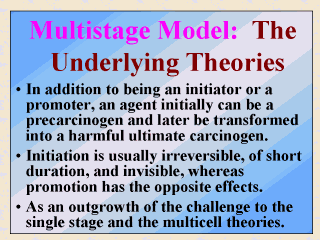| front |1 |2 |3 |4 |5 |6 |7 |8 |9 |10 |11 |12 |13 |14 |15 |16 |17 |18 |19 |20 |21 |review |
 |
In addition to
the initiation and promotion steps mentioned in the last slide, Miller and
Miller (1979) also suggested two additional stages for the induction of cancer by most
chemicals or agents. Some agents are initially unharmful precarcinogens that later
can be biotransformed into harmful ultimate carcinogens that are usually mutagenic
and electrophilic, those tending to bind to cellular macromolecultes (DNA, RNA, proteins,
etc.). In accordance with the classic Millers model, the early phase of the multistage process is generally described as initiation or transformation. The initiated cell(s) appears not to be visible as tumor cell(s) during this apparently irreversible phase involving a short(er) duration. This phase is presumed to exist, however, in that a subsequent phase known as promotion or progression can cause an activated (and only activated) cell to develop into tumor cells. Promotion per se is thought to be a highly complex long process, for which several (sub)stages are involved and the early ones are usually reversible. The classic system for the demonstration of this multistage process is the induction of skin tumor in mice. This system was based partly on Deelman’s induction scheme (1927), and in part on the somatic cell mutation theory of cancer advanced by Bauer (1928). More recent data showed that the classic two-event model is valid for sites other than animal skin. Dong (1984) also noted that although the classic initiation-promotion model has much to contribute, the multistage theory of carcinogenesis was actually an outgrowth of the challenge to both the single stage model and the multicell theory. |